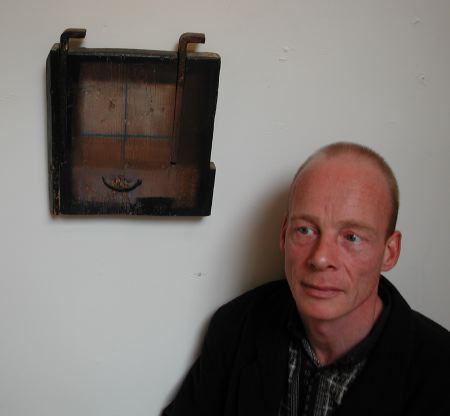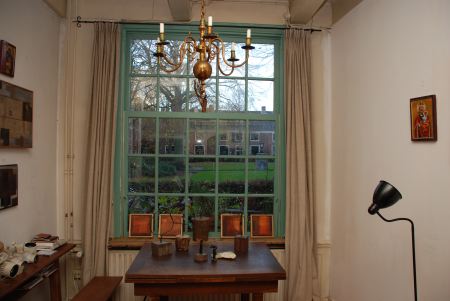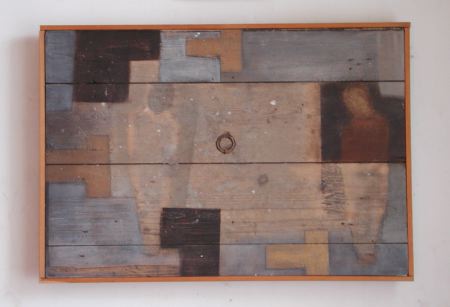
On the first day of class my freshman drawing teacher had us all go out and buy 9″ x 11″ hardbound sketchbooks. We were expected to carry them around with us over the course of the semester, and draw constantly. Now, thirty years later, I find that I have an encyclopedia set of these books filling a shelf in my studio. Keeping journals/sketchbooks has become an integral part of my art practice and my everyday life. But the way I use them has changed.
I think of a sketchbook as something you draw in, and a journal as something you write in. And though I’ve always used the same book for both, I see that mine have evolved over the years, from more sketchbook to more journal. In the early ones I did very involved drawings, sitting for hours doing studies from nature, or drawing people. These days the drawings in my journals tend to be notational, and if I do anything more finished it’s on single sheets of paper.
My journals function as sketchbooks, idea books, diaries and scrapbooks. I always have the current one with me, in the bookbag that I carry around, along with whatever I’m reading at the time. And over the years I’ve developed certain conventions for them. For example, I’ve gotten in the habit of starting each entry with the date, time and location, so it’s very easy for me now to look back through them and see when certain ideas initially occurred, or where I was when I was writing about something. I also, early on, started keeping a list on the back page of the journal of the books I read. I list the title, author, and the date I finished reading it, and if the book made a particularly strong impression on me I put a star next to it. So at this point I have a running list of pretty much every book I’ve read during my adult life, including re-reads, and a simple rating system that is useful when I want to go back and retrieve information, or recommend books to friends. When the journal is full I put a number on the spine and add it to the shelf, and I start a new one.
These journals serve several functions for me. The most obvious is that they’re a place to store ideas so I don’t forget them. Putting them down on paper also forces me to clarify the ideas somewhat, at least enough to put them into words or a sketch, and it also relieves me of the burden of carrying them around in my head. Often seeing the idea on paper helps to spur variations. Sometimes these ideas are visual, sometimes verbal. Sometimes I’ll start with a quick drawing, spin out a verbal list of associations or connections, and then do more drawings. So the journal becomes a place to not only record ideas but also to develop them.
The journals are not just for my art practice, but are part of my everyday life. I use them as diaries; to record my thoughts, concerns and activities. They are scrapbooks that contain newspaper clippings, postcards and concert tickets. I’ve been writing songs almost as long as I’ve been painting, and the journals contain endless lists of possible titles. It’s pretty obvious how a title can be a starting point for writing a song, but I’ve also had titles launch whole series of paintings. The old cliche about a picture being worth a thousand words also works in reverse –a word can evoke a thousand pictures. Sometimes the same title will result in both a song and a painting. I keep all of these possibilities pretty open-ended, and don’t try to figure them out right away.
Keeping the journals has taught me a lot about my creative process. I see ideas appear, and then reappear months or even years later, but changed in some way. Like they’ve been percolating under the surface, accumulating resonance and layers of meaning without my awareness. I can read diary entries from years ago, see the things I was excited or worried about, and gain perspective on how they’ve played out in my life. And most of all, the journals are a library of ideas, some terrible and some pretty good, more ideas than I could ever execute in several lifetimes. I’ve learned not to edit or judge the ideas when I get them, everything goes in, and later when I look back through I pick the ones that are most promising to pursue.
When people visit my studio and see the journals lined up on my shelf, they say “Oh, you must be very disciplined. I’ve tried to keep journals before, but I always stop.” But the truth is that I’m not disciplined about it at all. Here’s the big secret, the way I’ve been able to keep these journals going all these years – I don’t write or draw in them every day. When you try to do something as a discipline, like a diet or a New Years resolution, it’s easy to start out very gung ho, then miss a day or two, and decide that you’ve failed and you might as well give up. In my case, sometimes I’m working in the journal several times a day, and other times weeks will go by without an entry. But I’ve always got it with me, so it’s there when I need it.
I’m sure many of you keep sketchbooks or journals of some kind. In what ways is your process similar to mine? How is yours different?








